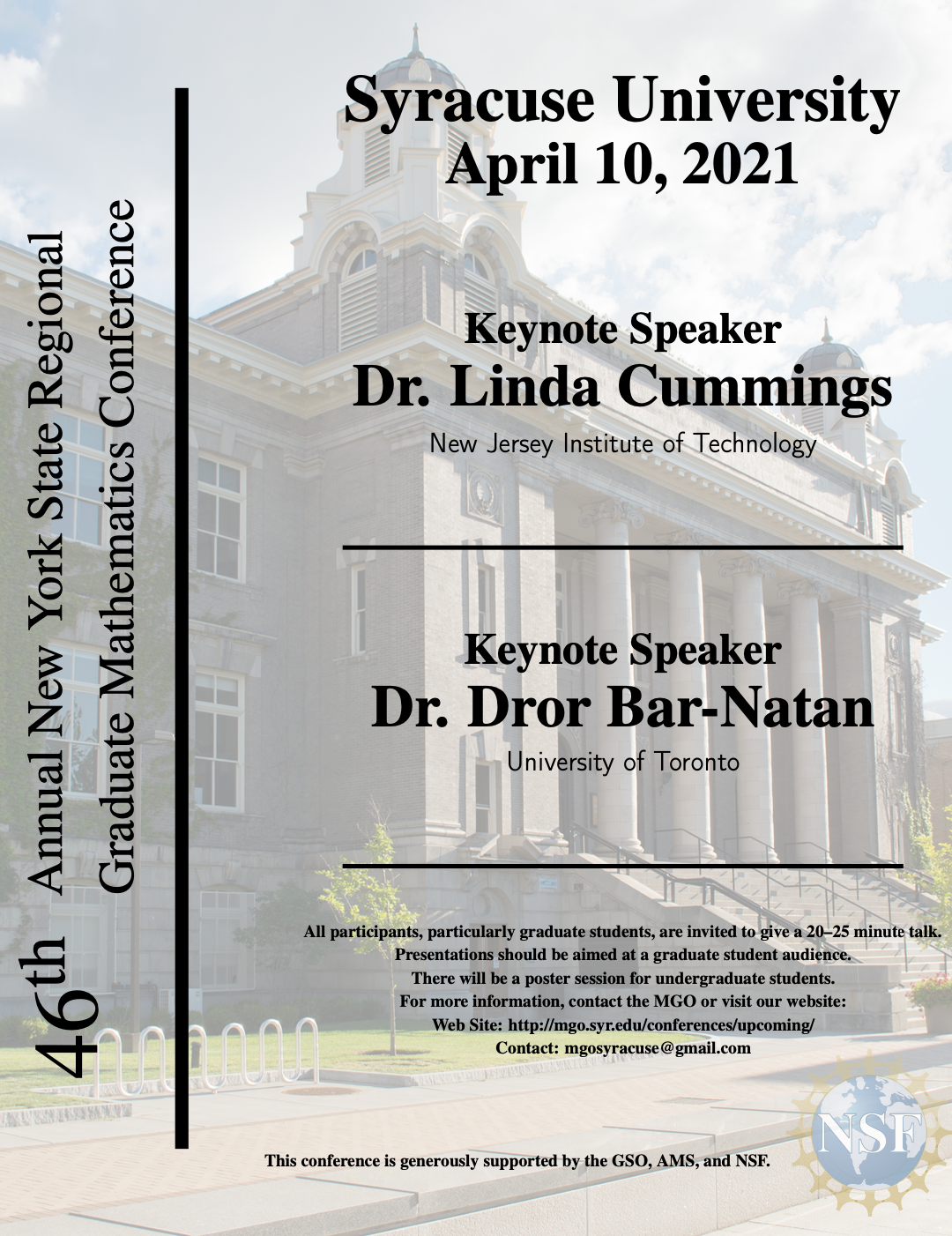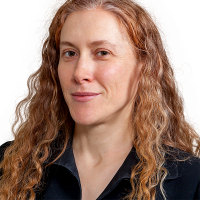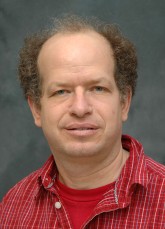46th Annual New York State Regional Graduate Mathematics Conference
Date: April 10, 2021
Contents

About the Conference
The Annual New York State Regional Graduate Mathematics Conference (ANYSRGMC) is the longest running graduate mathematics conference in the country, and is organized entirely by graduate students. ANYSRGMC is a Mathematics conference dedicated to providing an opportunity for mathematics graduate students in any field to present their research or give an expository talk. The ANYSRGMC allows students from many fields and schools, who normally are not given a chance to interact, an opportunity to come together and explore a wide variety of mathematical topics simultaneously. Students have a unique chance to explore their interests, gain new insights across fields, and explore possible cross-disciplinary collaborative efforts. This is a unique opportunity for beginning graduate students to see a broad range of current mathematical research simultaneously and explore their interests. Though the focus of ANYSRGMC is on graduate students, advanced high school students or undergraduates, post-docs, and professors are welcome to attend and give talks. It is our goal to develop careers, broaden horizons, and engage the mathematics community at large. We hope to see you at the conference!
Conference Registration
You may register for the 46th Annual New York State Regional Graduate Mathematics Conference at this link or using the link below. Registration is open until the day of the conference; however, if you plan on giving a talk or presenting a poster, you must submit your title and abstract by March 27, 2021. If the deadline has passed but you wish to give a talk or present a poster, please, contact the organizers to check if arrangements can be made. Funding for the conference has been made possible by support from the Syracuse Mathematics Department, Graduate Student Organization, the American Mathematical Society (AMS), and by the National Science Foundation (NSF).
Date, Location, & Format
Because of the on-going threat and restrictions caused by the COVID-19 pandemic, the 46th Annual New York State Regional Graduate Mathematics Conference will be held entirely online on Saturday April 10, 2021. Details about times, talks, and the Zoom links are forthcoming and will be sent via email and posted to the conference webpage. The conference will consist of two plenary talks and dozens of graduate student talks given in parallel sessions. All graduate students at any stage of their graduate education are welcome and encouraged to give a 20–25 minute talk. Talks may be expository or on the student’s research. Undergraduate students participating in the conference may present a poster on original/expository material or they may give a talk—in either case the material should be ‘appropriate’ for the conference. The deadline for submitting a talk or poster proposal is March 27, 2021.
Keynote Speakers
Dr. Linda Cummings (New Jersey Institute of Technology)

Professor Cummings received her BA and Ph.D. from the University of Oxford under Professors Ockendon and Howison. She then held postdoctoral positions at the Technion and the Ecole Normale Superieure (Paris), before moving to the EPSRC and Dorothy Hodgkin Fellowships at the University of Nottingham. Professor Cummings then was a faculty member beginning in 2005 at the University of Nottingham before beginning her current residency as a faculty member at the New Jersey Institute of Technology in 2008. She has written dozens of papers and had 11 Ph.D. students. Her research interests are in Applied Mathematics, including fluid dynamics, liquid crystals, free boundary problems, asymptotics, complex variable methods, and mathematical modeling of industrial and biomedical systems.
Dewetting and dielectrowetting in thin films of nematic liquid crystals
Abstract: Thin films of nematic liquid crystal (NLC) find widespread industrial use, in applications ranging from liquid crystal display devices to liquid lenses and optical shutters. Understanding how such films spread and flow is therefore important from an industrial perspective as well as being of fundamental scientific interest. We will describe how asymptotic methods (lubrication theory) can be applied to derive a simplified model for the free surface evolution of NLC films in a number of different settings. Of particular importance for film behavior is the orientation of the NLC molecules, both within the bulk film and at interfaces. The former is dictated by elastic effects and by the presence of applied external fields such as an electric field; while the latter depends primarily on interactions of the NLC with the adjacent material (a phenomenon known as anchoring). We will present simulations of our model that illustrate film behavior both without (dewetting) and with (dielectrowetting) an applied electric field, showing good qualitative agreement with available experimental data.
Dr. Dror Bar-Natan (University of Toronto)

Professor Bar-Natan received his B.Sc. in in mathematics at Tel Aviv University in 1984. After performing his military service as a teacher, he started his studies at Princeton University. He received his Ph.D. in 1987 under the direction of physicist Edward Witten. Dr. Bar-Natan then held the Benjamin Peirce Assistant Professorship at Harvard University from 1991 to 1995. After returning to Israel, he became an Associate Professor at the Hebrew University of Jerusalem. Professor Bar-Natan then moved to the University of Toronto as a professor starting in 2002. He has written dozens of papers and had 7 Ph.D. students. His research interests include knot theory, finite type invariants, and Khovanov homology.
Knots in Three and Four Dimensions
Abstract: Much as we can understand 3-dimensional objects by staring at their pictures and x-ray images and slices in 2-dimensions, so can we understand 4- dimensional objects by staring at their pictures and x-ray images and slices in 3-dimensions, capitalizing on the fact that we understand 3-dimensions pretty well. So we will spend some time staring at and understanding various 2-dimensional views of a 3-dimensional elephant, and then even more sim- ply, various 2-dimensional views of some 3-dimensional knots. This achieved, we’ll take the leap and visualize some 4-dimensional knots by their various traces in 3-dimensional space, and if we’ll still have time, we’ll prove that these knots are really knotted.
Registered Participants
Click here for a list of registered participants.
Schedule and Abstracts
Click here for a list of abstracts and the conference schedule.
Contact Us
If you require any accommodations, or have any questions, comments, or concerns, please contact us at mgosyracuse@gmail.com, or click this link to send an email now.